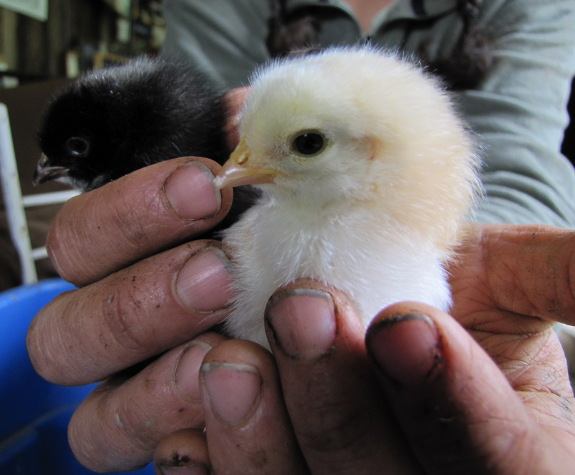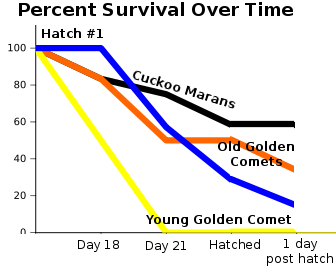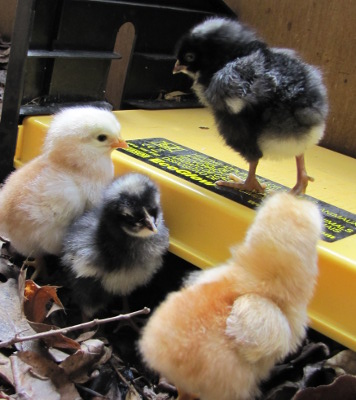
Hatch two conclusions and hatch three plans

Three and a half days
after the first
chick hatched (and a
day and a half after I helped
the last chick out of its shell),
my obsession level finally diminished enough that I wasn't compelled to
check on the chicks every ten minutes. If you can believe it,
chick hatching actually trumped strawberry harvesting for a couple of
days there (which is why I had enough strawberries so early in the
season to pick a whole bowlful two days in a row and could make chocolate
strawberry shortcake.)
Maybe by the next hatch, I won't be so nervous that I'm unable to do
anything else while eggs are pipping?
 My final hatch rate was 9
living chicks (and one cull) out of 24 eggs. Certainly not as
good as I was hoping when I counted
my chickens before they hatched,
but drastically better than my first hatch (which netted 1 chick out of
7 eggs.) In fact, the hatch rate this time around was actually
better than it looks since my autopsy on day 23 showed that four of the
eggs were infertile, mostly from that old hen who just started laying a
month ago. People generally don't count infertile eggs in their
hatch
calculations, so our hatch rate was 45% --- 25% for our old hens and
58% for the prime cuckoo marans eggs.
My final hatch rate was 9
living chicks (and one cull) out of 24 eggs. Certainly not as
good as I was hoping when I counted
my chickens before they hatched,
but drastically better than my first hatch (which netted 1 chick out of
7 eggs.) In fact, the hatch rate this time around was actually
better than it looks since my autopsy on day 23 showed that four of the
eggs were infertile, mostly from that old hen who just started laying a
month ago. People generally don't count infertile eggs in their
hatch
calculations, so our hatch rate was 45% --- 25% for our old hens and
58% for the prime cuckoo marans eggs.
 Since the folks we were
fostering half of our australorps
for probably don't want them after all, it looks like we might just
need one more hatch to reach quota for the year. We've given up
on our hens as gene donors (and are more impressed with the foraging
abilities of our black australorps anyway), so we've ordered twenty
australorp hatching eggs from Golden Willow Farm.
They're the folks who sent us the cuckoo marans eggs, and I like the
fact that their stock have access to real pasture. I'm aiming for
a hatch rate of 65% this time around (13 chicks), which I hope to
achieve by sanding off any bits of poop on the eggs. (Infection
is a common cause of egg loss midway through the incubation period,
which is the one part of the cycle where we did worse during this hatch
than the first time around. Incidentally, several of the eggs
were slightly dirty.) Wish us luck as we go into round three!
Since the folks we were
fostering half of our australorps
for probably don't want them after all, it looks like we might just
need one more hatch to reach quota for the year. We've given up
on our hens as gene donors (and are more impressed with the foraging
abilities of our black australorps anyway), so we've ordered twenty
australorp hatching eggs from Golden Willow Farm.
They're the folks who sent us the cuckoo marans eggs, and I like the
fact that their stock have access to real pasture. I'm aiming for
a hatch rate of 65% this time around (13 chicks), which I hope to
achieve by sanding off any bits of poop on the eggs. (Infection
is a common cause of egg loss midway through the incubation period,
which is the one part of the cycle where we did worse during this hatch
than the first time around. Incidentally, several of the eggs
were slightly dirty.) Wish us luck as we go into round three!
Want more in-depth information? Browse through our books.
Or explore more posts by date or by subject.
About us: Anna Hess and Mark Hamilton spent over a decade living self-sufficiently in the mountains of Virginia before moving north to start over from scratch in the foothills of Ohio. They've experimented with permaculture, no-till gardening, trailersteading, home-based microbusinesses and much more, writing about their adventures in both blogs and books.
Want to be notified when new comments are posted on this page? Click on the RSS button after you add a comment to subscribe to the comment feed, or simply check the box beside "email replies to me" while writing your comment.

Just to give the Australorps one last plug - while researching chicken predators after our recent fox attack, I read that most predators will go after the light-coloured chickens first. I guess they're easier to see in the dark or in twilight, when most attacks occur. None of the chickens we lost in the attack were black or dark.
I'm hoping my Australorps have the ninja stealth skills to evade future attacks!
I wish they'd go after our light-colored chicken. (I need to just eat that useless cochin, but I'm waiting until our first pullets begin to lay since egg production is already low.)
I was so completely in love with our Golden Comets, but I love our australorps more. I wonder if I'll change my tune again in a couple of years when I meet an even better breed?